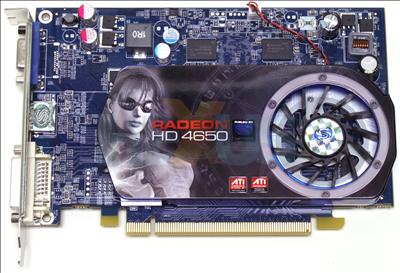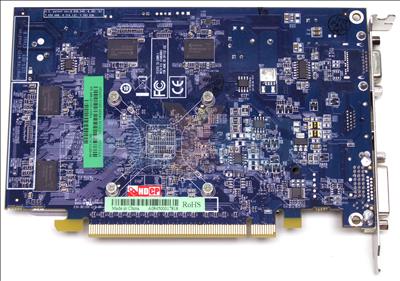Sapphire Radeon HD 4650 512MB GDDR3
The Radeon HD 4650 makes up the mainstay of ATI partners' business in the £50-£65 space, where it competes against NVIDIA GeForce 9500 GT as a worthwhile step-up solution for folks wanting to upgrade their computers from integrated graphics.Imbued with 320 stream processors and a healthy feature-set, most HD 4650 cards are generic in design, minimising cost, and ship with clocks of 600MHz core/shader, and 1,000MHz memory, via cheap-as-chips DDR2 RAM. Those are the products you'll likely see for around £50 when looking online.
Sapphire retails such a card (11140-02-20R ) and it's purely generic in design, costing £55 or so. Go a little up the range and you come across one that uses GDDR3 memory for greater bandwidth and higher performance, plus on-board HDMI so that you don't have to use an adapter when transferring sound and audio to an external display or amp.
The GDDR3 version keeps the core/shader clocks at 600MHz but raises memory frequencies from 1,000MHz to 1,400MHz. There's still 512MB on the card, and the GDDR3 chips are provided, in this instance, by Qimonda, nominally rated at 1,428MHz.
Memory bandwidth is based around a 128-bit interface, meaning it's increased from the usual 16GB/s to 22.4GB/s on this card: nice.
Faster RAM will push the price up, of course, and this version currently retails for around £62.
The cooler keeps the GPU chugging along with the minimum of fuss, and it's very quiet when twiddling its silicon thumbs rendering 2D or when put under the cosh when playing games.
Using a PCI-Express 2.0 interface, as most modern graphics cards do, another card can be teamed up, via internal CrossFireX, and run in multi-GPU mode.
The memory chips, four on each side, are left without heatspreaders, and we see little reason why Sapphire should apportion part of the budget for them.
Low power-draw means that you don't need an additional power-connector to fire it up; the PCIe x16 slot is enough on its own.
Output choices are eminently sensible for this low-to-mid-range card, because D-Sub (for older monitors), dual-link DVI, and HDMI should have most of the bases covered between them. HDMI, in particular, is handy, and means that you don't need a large-ish dongle sticking out of the back of the card.
Two of the three display outputs can be used simultaneously, by the way.
Summary
This particular Radeon HD 4650 is distinguished from the norm by having GDDR3 memory, which is uncommon, and also fielding an on-the-backplate HDMI port as standard. You pay around £10 more for this privilege, though.














